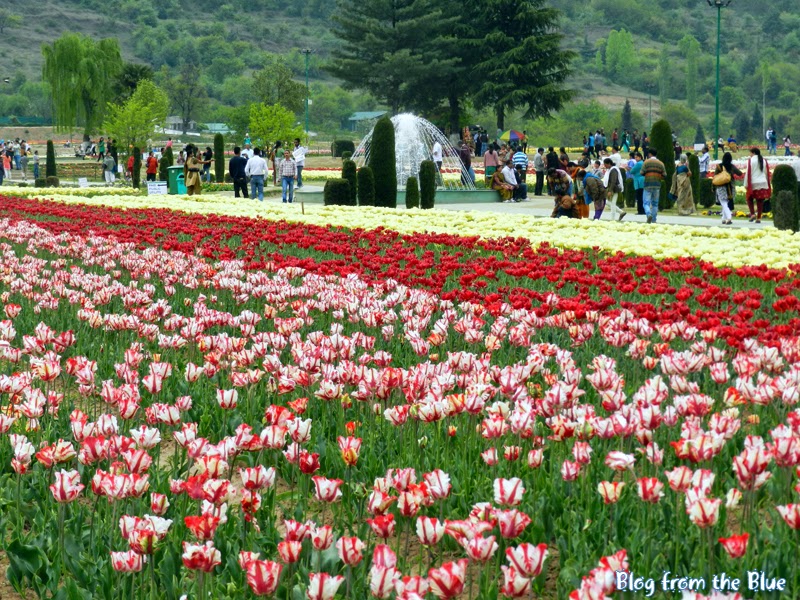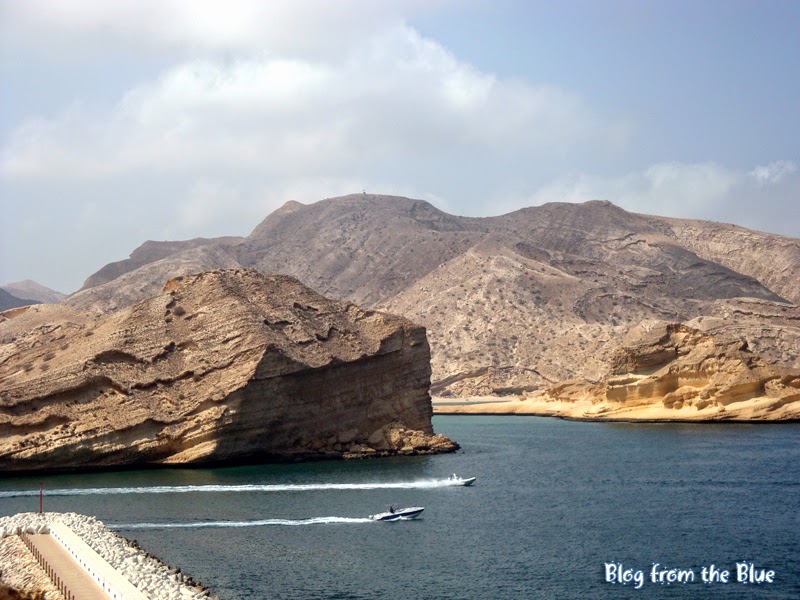Kashmir – a place that has been associated
with Paradise since ages, a destination that has been every Indian’s dream to
visit, a valley that has caught every traveller’s fascination, a backdrop that
has been filmed by numerous Indian movies of the bygone days. My childhood
dream of visiting this heaven on earth- mostly fuelled by the Eastman coloured
Hindi movies and fascinating travel stories has been slowly fading away. Modern
day Indian films too have ignored Kashmir and found many better backdrops
abroad while the terrorists have found Kashmir
a better place to dwell! The insurgent activities have taken a toll on the
tourism industry of Kashmir and the heaven
started to become a hell.
I had to cancel once my planned trip to Kashmir due to the unrest in the valley. However, things
are changing and hope it will continue to change for better and the tourism in
this valley will prosper in days to come.
After much planning and thinking, one fine
day, we flew from Muscat to Srinagar
– the capital of Kashmir. It was April 2012, a
great time to visit the valley, a season when the Tulips bloom and the ice
starts melting. The situation of the valley was normal and tourists, mostly
Indians have packed out all the must visit sites!
The first view: As our plane was
approaching Srinagar,
a magnificent panorama of snow capped mountains and yellow mustard fields
appeared through the flight windows. Wish I had a window seat with a high
resolution camera ready in my hands! Nevertheless, I kept my eyes wide open and
tried to grab as much as possible this view of heaven from the top! Certain
memories do not need a camera to hold, they are imprinted on mind. This was one
of such memories.
The Dal
Lake: The purpose of writing this
article is to tell you about the hundreds of years old magnificent gardens of Srinagar. Yet, no writing
on Srinagar is complete without mentioning the Dal Lake –
the jewel of Kashmir, a sprawling lake of over
25 square km right at the heart of the city. This is the lake from where river Jhelum has originated. Nagin
Lake and Wullar Lake
are the two other prominent lakes in the city. These lakes are almost frozen
during the winter. The spring and summer are best time for tourists to enjoy
the beauty of Kashmir, be it the blooming
flowers, yellow mustard fields or a night stay at one of the many houseboats
across the length and breadth of these lakes. It’s truly an unforgettable
experience to stay on these houseboats floating over the scenic lake with a
panoramic view of the mighty snow clad mountains.
 |
| Floating market at Dal Lake, Srinagar, Kashmir |
The
Dal
Lake is also famous for its Shikara
ride – a quintessential boat ride also known as the water taxi of
Kashmir. Shikara can be used to visit the floating
market, the floating vegetable & flower gardens, the floating post office
and the majestic gardens such as Shalimar Bagh or Nishat Bagh.
This lake has found its place in many
creative works and continues to inspire the artists be it for a creative art or
for a lyrical masterpiece!
 |
| Shikaras at Dal Lake, Srinagar, Kashmir |
The breathtaking view of this lake also
compliments the royal gardens of
Kashmir about
which I’m writing in the following passages.
Shalimar Bagh: Way back in the year 1616,
Mughal emperor Jahangir built this beautiful garden for his beloved wife Noor
Jahan. Designed in Persian style, this garden is surrounded by Chinar trees and
is full of fountains, flowers and manicured gardens. The garden has got three
terraces – each one designed with a specific purpose. During the rule of the
Mughals, only the first terrace – known as Diwan-e-Aam was opened to the public.
The second terrace was reserved for the royal guests and aristocrats and it was
called Diwan-e-Khas. The third and the highest one called Zenana or Harem was
only for the king and his wives.
Nishat Bagh: This is largest of all the
Mughal gardens of Kashmir. Designed by
Jahangir’s broder in law Asaf Khan, this garden was built in the year 1633.
Located on the eastern banks of Dal
Lake, Nishat Bagh, which
means garden of joy, has 12 terraces, each one full with flowers, lawns and
tall trees – the most impressive of which are the chinar and cypress trees.
All the terraces of Nishat Bagh have water pools coupled with fountains, the 11th one has the highest number of fountains, 25. The 12th terrace or the Zenana terrace was exclusively for the King and the royal ladies.
Nishat Bagh is at a distance of 25 km from the airport and can be reached by both road or a Shikara ride on the Dal Lake
Chasme Shahi Garden:
 |
| Chashme Shahi Garden, Srinagar |
Built in the year 1632 during the Shah Jahan
rule, this one is the smallest Mughal
garden of Kashmir.
The garden is full with different varieties of fragrant flowers, lawns, waterfall
and fountains and provides a breathtaking view of the green mountains.
The name Chashme Shahi means the royal
spring and the garden is built around a spring. The water of the spring is
believed to have medicinal importance. The garden is designed in Persian style
and it overlooks the mighty Dal
Lake on one side and the
Zabarwan hills on the other.
 |
| Chashme shahi Garden, Srinagar |
Char Chinar Garden :
This one is a tiny island garden located in
the
Dal Lake which can be reached by a Shikara
boat. The name char chinar is derived from the four Chinar trees that stand
across the boundary of the island as a landmark. Chinar trees grow in abundance
in this region and have been a pert of Kashmiri life and tradition.
 |
| Char Chinar Garden, Srinagar |
Pari Mahal:
 |
| Pari Mahal, Srinagar |
Located on the slopes of
Zabarwan hills, near the
Chasme
Shahi Garden,
this charming garden was built at the ruins of a Buddhist monastery. This
ancient monument is believed to be constructed for the purpose of astronomical
observations by prince Dara Shukoh, the eldest son of Shah Jahan in the year
1650. He named it after his wife Nadira
Begum, who was also known as Pari Begum.
The garden of Pari Mahal
has six terraces spreading across an area of over 7500 square meters. The
gardens are watered by a nearby spring.
Tulip Garden:
 |
| Tulip Garden, Srinagar |
This is
a new addition to the age old tradition of Kashmiri gardens. Decorated with
lines of different varieties and colours of Tulip flowers spreading across 15
hectars, this garden is a real delight to the senses. One of the most visited
attractions of
Srinagar,
the ideal time to visit this garden is during March and April when the flowers
are in full bloom. The garden was opened only a few years ago and since then it
has found a place in the heart of the tourists. Tulips are very delicate
flowers and can be grown only in favourable weather conditions.
Kashmir is one of the very few places on earth that suits
the Tulip plantation. Over 1.2 million Tulips of different varieties bloom
every year here making this garden look like a colourful carpet on the
foothills of Zabarwan mountains
 |
| Tulip Garden, Srinagar |
 |
| Tulip Garden, Srinagar |
 |
| Tulip Garden, Srinagar |
Apart from these wonderful gardens and
lakes,
Srinagar has many other attractions - Hazratbal Mosque, Hari Parbat Fort,
Shankaracharya Temple,
Sri Pratap Singh
Museum and so many other
tourist places which I could not visit during my short stay in the city. Finally,
I conclude by sharing a few advices which might be helpful if you are planning
a vacation to
Srinagar
for the first time.
1. How to reach: Srinagar airport is well
connected with the international airports in Delhi and Mumbai. Some flights also have a
stopover at Jammu.
The airport security is very tight and time consuming. Be prepared for it and
reach the airport early while returning. Srinagar
can also be reached by car from nearest railway station Jammu
(258 km) and from Delhi
(876 km)
2. Be aware: Keep a track of the latest
happenings in the state and if you come across any news of violence or unrest
in the region, do not hesitate to cancel the trip even at the last moment.
3. Be safe: Book the accommodation well in
advance. The tourists are often approached by stray agents, guides or porters.
Better to avoid them. Also, do not buy anything from roaming vendors who try to
lure the tourists to sell their products or services.
4. Be careful: Keep your belongings safely.
Never trust strangers.
5. Dealing with locals: Bargain hard. The
price is often overstated to the tourists, particularly the foreigners.
6. Things to buy: Kashmir is famous for Cashmere (Pashmina) shawls. You can buy it as a souvenir
or for your winter use, but only from a good store. Never buy from stray
vendors. You can also consider buying carpets and saffron (kesar).
7. Nearby attractions: Gulmarg, Pahalgam
and Sonmarg are some of the great places to visit while you are in Srinagar. You can also
plan one or two night-stays in some of these places. Kashmir
is full of natural beauty. Try to enjoy it as much as possible with a well
planned itinerary.
Notwithstanding the underdeveloped tourism
industry of the state and incidences of violence, tourists can’t resist visiting
Kashmir for its scenic beauty and the
paranormal experience of heaven on earth. The beauty of
Kashmir
can only be felt by staying there and exploring the city at a slow pace. It’s a
must visit destination for all, particularly for nature lovers.
Kashmir is awe-inspiring, incredible, out of the world -
I could have written more, only if I had any word left in my vocabulary.

































































